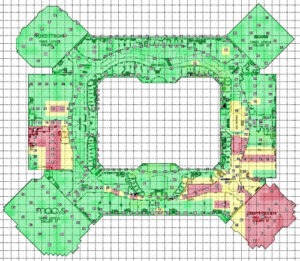
Public safety radio coverage is essential for first responders to communicate effectively in the event of an emergency. However, buildings can often block radio signals, making it difficult for first responders to communicate inside. Grid testing is a method of measuring and mapping radio signal coverage in a building. This information can be used to identify areas where radio signal coverage is weak or non-existent, and to install equipment to improve coverage.
Grid testing is typically conducted by a qualified professional using specialized equipment. The process involves dividing the building into a grid of squares or rectangles, and then testing the radio signal strength at each point in the grid. The results of the test are then used to create a map of radio signal coverage.
Grid testing is an important part of ensuring that public safety radio coverage is adequate in all areas of a building. By identifying and addressing areas with weak or non-existent radio signal coverage, first responders can be assured that they will be able to communicate effectively in the event of an emergency.
Benefits of Grid Testing
There are many benefits to grid testing for public safety radio coverage. Some of the benefits include:
- Improved communication for first responders: Grid testing can help to identify areas where radio signal coverage is weak or non-existent. This information can then be used to install equipment to improve coverage, which can help to ensure that first responders can communicate effectively in the event of an emergency.
- Increased safety for first responders: Improved communication can help to increase the safety of first responders by allowing them to communicate with each other and with dispatch more easily. This can be especially important in emergency situations where first responders need to coordinate their actions quickly and effectively.
- Reduced risk of property damage: Grid testing can help to identify areas where radio signal interference is occurring. This information can then be used to take steps to reduce or eliminate the interference, which can help to reduce the risk of property damage caused by electrical fires or other incidents.
How to Conduct Grid Testing
Grid testing can be conducted by a qualified professional using specialized equipment. The process typically involves the following steps:
- Divide the building into a grid of squares or rectangles.
- Test the radio signal strength at each point in the grid.
- Create a map of radio signal coverage.
The size of the grid will vary depending on the size of the building. For large buildings, it may be necessary to divide the building into multiple grids. The type of equipment used for grid testing will also vary depending on the size and type of building.
Conclusion
Grid testing is an important part of ensuring that public safety radio coverage is adequate in all areas of a building. By identifying and addressing areas with weak or non-existent radio signal coverage, first responders can be assured that they will be able to communicate effectively in the event of an emergency.
Brian Martin
Global Communication Services, LLC
